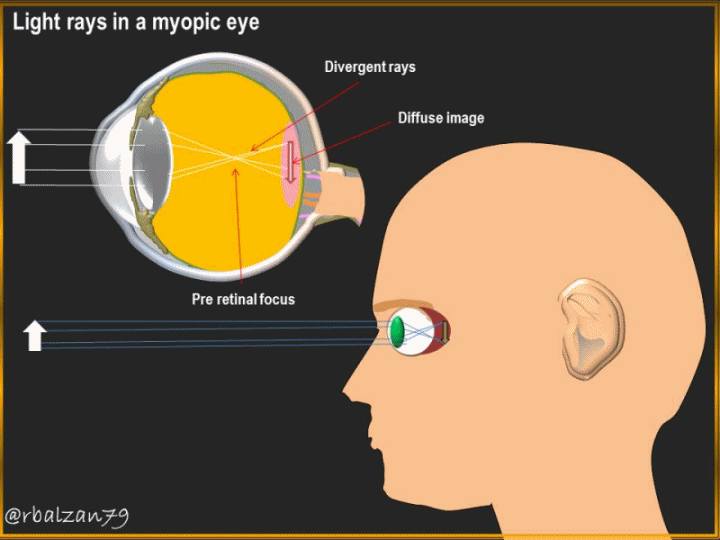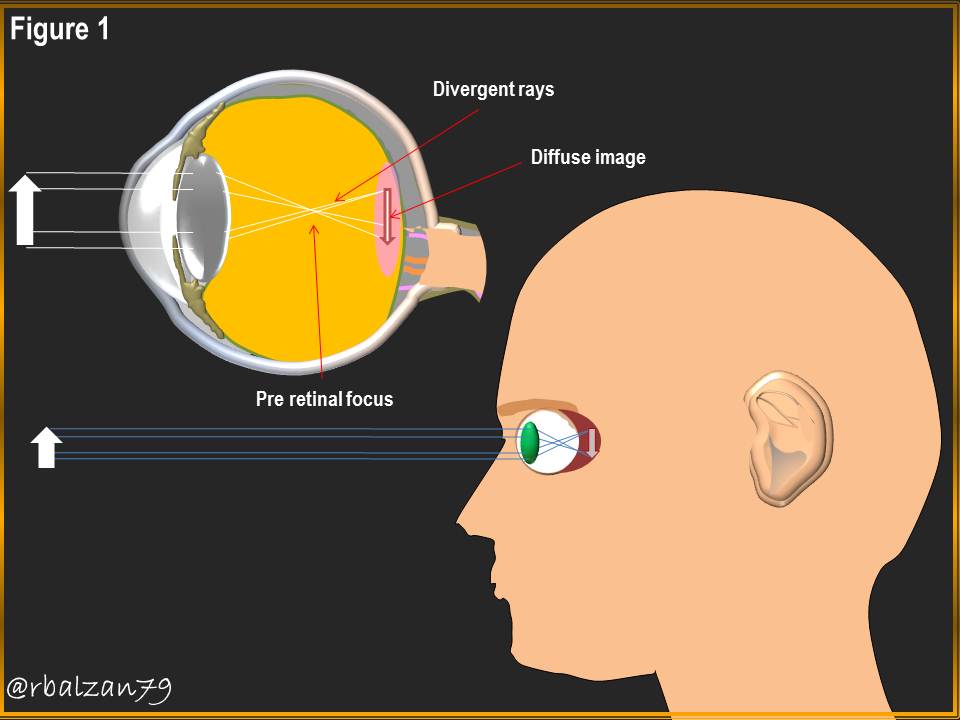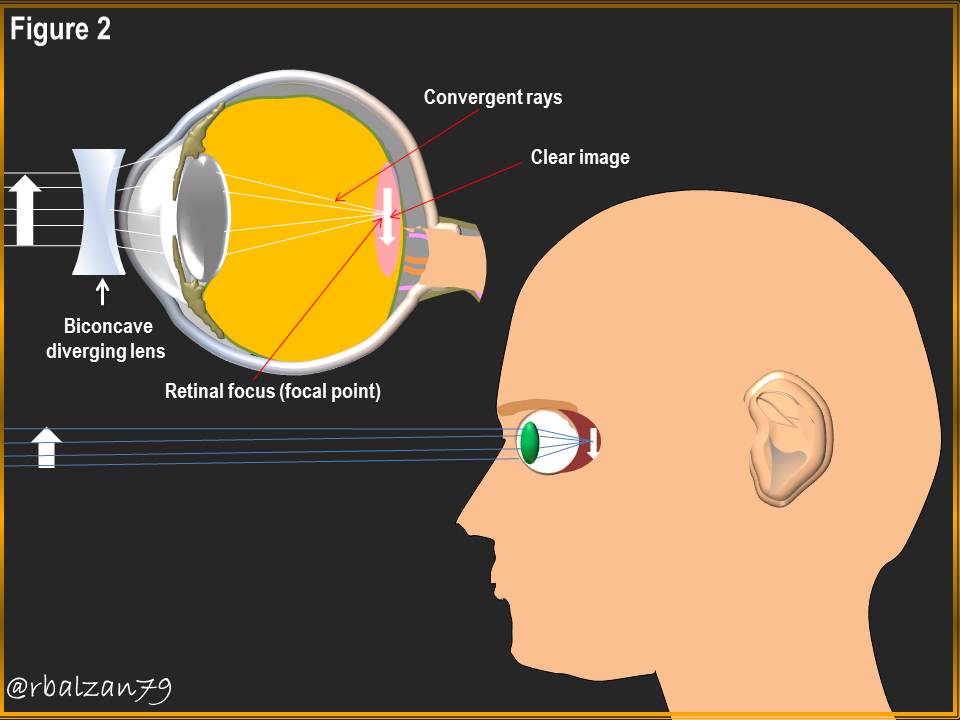The refractive power of our natural lenses_Part II (Myopia)

Introduction
Thanks to the phenomenon of light we have been able to visualize everything around us, and this is because the light rays emitted by any body or object carry their shape or figure to our retina, therefore, this occurs through the process of propagation of light, and in this process other phenomena such as refraction are developed, and the same, of great interest to the subject raised.
Light propagates generally from one side to the other through the air, however, it is not the only material or elastic medium implemented by the light, therefore, in this way it will find in its way with any type of object or obstacle which will have incidence in the directionality of such light rays and this phenomenon is what we know as refraction, and each material or elastic medium has its particular refractive power.
In the previous article we began to relate to the refractive power of essential elements of our natural optical systems (eyes), that is, the cornea and the crystalline lens, in terms of the passage of light, and both represent the optical components of the human eye with the highest refractive power.
It is important to highlight that in artificial optical instruments some defocusing processes are developed when the lenses refract the light, and these are known as optical aberrations, this type of defocusing occurs in the same way in our eyes generating in this way the so called ametropias or refractive vices, where we will start this time with myopia, therefore, it is important to note that when there is no defocusing of light rays in our retina we are in the presence of a normal natural optical system or an emmetropic eye as you could see in the previous article.
Light rays in a myopic eye
When we speak of a myopic eye is because we are in the presence of an ametropia, and it is usually due to the fact that the human eye sometimes has or has greater axial length than normal, however, my dear readers, it is important to note that such ametropia can also occur due to certain refractive problems related to an inadequate curvature of the cornea.
In relation to the above we can say that myopia can also develop because our lens has great refractive power, and thus, a high value in diopters, therefore, the light rays converge in front of the retina, that is, a focal point called preretinal originates, where, from this focus (preretinal) divergent rays will leave form reaching the retina, and thus, generating unfocused or diffuse images, this can be seen in a general way in the following figure 1.

In the previous figure 1, you could clearly see how the light rays entering our eye form a focal point in front of our natural screen or retina, that is, in the vitreous, and from there, these rays diverge until they reach the retina, thus generating blurred or unclear images which are transmitted by the optic nerve to our brain.
The physical science implemented in technology has achieved the correction of this ametropia (Myopia), and this thanks to the implementation of artificial lenses, as you can see in the following figure 2.

In the previous figure 2, we can visualize the correction of this type of refractive defocus or ametropia, and this thanks to the use of a concave or biconcave divergent lens, and whose value in diopter, is negative, as it was demonstrated in the first delivery.
With the implementation of these lenses, the luminous rays diverge when they come into contact with it, and then when they hit our cornea and crystalline lens, these luminous rays form the focal point on the retina, and thus, the generation of sharp images, this type of divergent lenses is possible to observe them in optics, and we would recognize them when we see their value in negative diopters.
Conclusion
Undoubtedly, my dear readers, every knowledge obtained about the different phenomena around us has been of vital importance for our exponential development, and the phenomenon of light represents a remarkable example of the above mentioned.
Any area of human development depends fundamentally on light for the realization of its functions, which is why the great historical interest of mankind to obtain any kind of knowledge about the phenomenon of light, and where physical science has played an essential role through its optics.
When analyzing light as a means of transporting images, it will undoubtedly always be necessary to relate to the intrinsic phenomenon of refraction, and with it, the Diopter which represents the value of the refractive power of a given material or elastic medium as we have done so far with artificial lenses such as the natural lenses of our eyes (cornea and lens), and the latter responsible for the focus or convergence of light rays on our retina.
We notice how the defocusing or non-convergence of the luminous rays in our retina brings as a consequence the ametropias or refractive vices as the one analyzed in a general way in this opportunity, that is to say, the Myopia which you could visualize in the previous figures, and in addition, how it is possible its correction through the implementation of artificial lenses.
Until another opportunity my dear readers of Hive, especially to the members of the great community of #stemsocial, for which I highly recommend to be part of this beautiful project, as it highlights the excellent work of academia and especially the great work of the entire scientific field.
Note: All images were created using the Power Point application and the animated gif was created using the PhotoScape application.
Recommended Bibliographic References
[1]What’s a Diopter, and Why Do I Care Anyway?
[3]Refractive power of lenses (Diopter). Author: @rbalzan79.
[4]Refractive power of lenses (Diopter)_Part II. Author: @rbalzan79.
[5]The refractive power of our natural lenses / Diopter of the human eye. Author: @rbalzan79.
Hi @rbalzan79 content of interest and masterfully presented. The interest of navigating knowledge is to have a clear vision within the circumstances. Thank you.
Hello friend @alfonsoalfonsi.
Thank you for your emotional and valuable comment, science always excites us and allows us to share any kind of knowledge related to the various phenomena that develop in our environment. Greetings and many successes.
Thanks for your contribution to the STEMsocial community. Feel free to join us on discord to get to know the rest of us!
Please consider supporting our funding proposal, approving our witness (@stem.witness) or delegating to the @stemsocial account (for some ROI).
Please consider using the STEMsocial app app and including @stemsocial as a beneficiary to get a stronger support.
Your content has been voted as a part of Encouragement program. Keep up the good work!
Use Ecency daily to boost your growth on platform!
Support Ecency
Vote for Proposal
Delegate HP and earn more